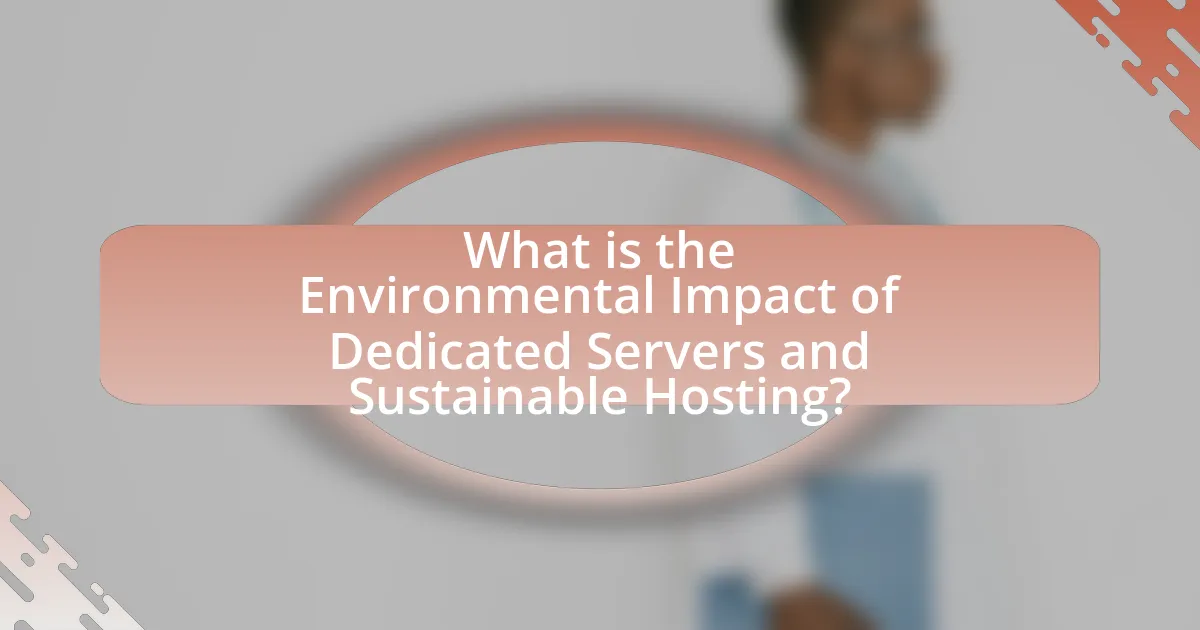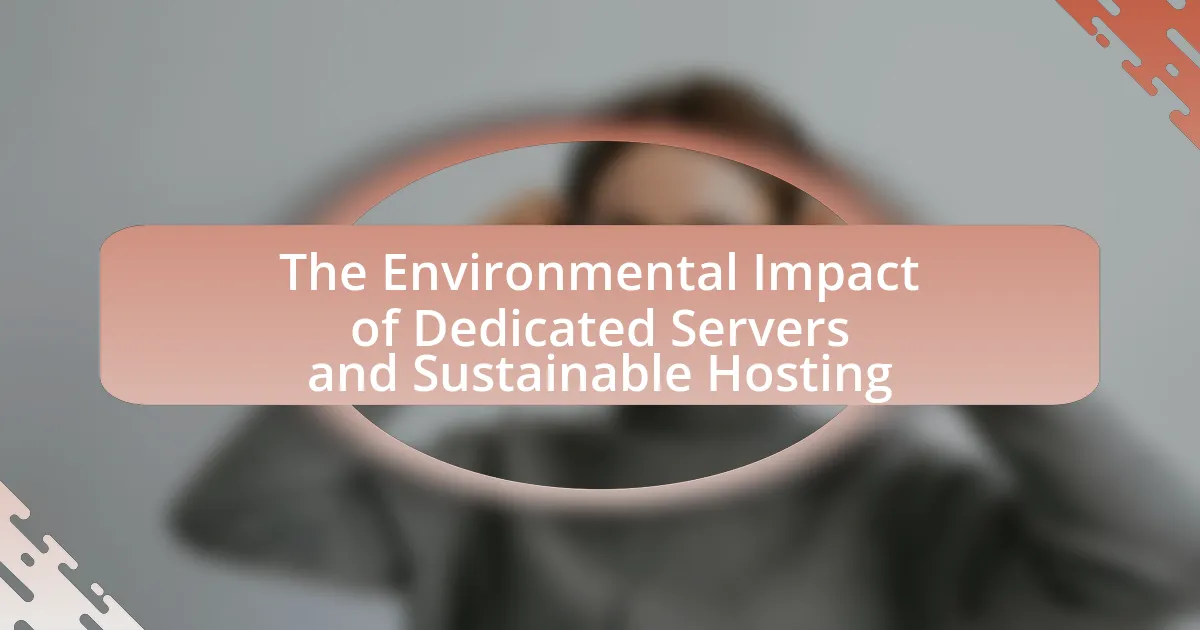Dedicated servers have a considerable environmental impact due to their high energy consumption and carbon emissions, with data centers accounting for about 1-2% of global electricity use. This article examines the environmental concerns associated with dedicated servers, including their contribution to greenhouse gas emissions and electronic waste. It also explores sustainable hosting practices that utilize energy-efficient technologies and renewable energy sources to mitigate these impacts, highlighting the benefits of transitioning to green data centers. Furthermore, the article discusses the economic implications of sustainable versus traditional hosting and offers practical tips for businesses to adopt sustainable hosting solutions effectively.

What is the Environmental Impact of Dedicated Servers and Sustainable Hosting?
Dedicated servers have a significant environmental impact primarily due to their high energy consumption and carbon emissions. These servers typically require substantial power for operation and cooling, contributing to increased greenhouse gas emissions. For instance, a single dedicated server can consume between 500 to 1,200 watts, leading to an annual carbon footprint of approximately 2,000 to 5,000 pounds of CO2, depending on the energy source used.
In contrast, sustainable hosting practices aim to mitigate these impacts by utilizing energy-efficient technologies, renewable energy sources, and optimized resource management. Sustainable hosting providers often invest in green data centers that employ advanced cooling systems and energy-efficient hardware, which can reduce energy consumption by up to 80%. Additionally, many sustainable hosting services commit to carbon offsetting, further decreasing their overall environmental footprint.
Research indicates that transitioning to sustainable hosting can significantly lower the environmental impact of web hosting services, with studies showing that green data centers can reduce energy usage by 30% to 50% compared to traditional setups. This shift not only benefits the environment but also promotes a more sustainable digital infrastructure.
How do dedicated servers contribute to environmental issues?
Dedicated servers contribute to environmental issues primarily through high energy consumption and significant carbon emissions. These servers require substantial power for operation and cooling, leading to increased greenhouse gas emissions, especially when powered by fossil fuels. For instance, data centers, which house dedicated servers, account for about 2% of global electricity use, according to the International Energy Agency. Additionally, the production and disposal of server hardware contribute to electronic waste, further exacerbating environmental degradation.
What are the primary environmental concerns associated with dedicated servers?
The primary environmental concerns associated with dedicated servers include high energy consumption, electronic waste generation, and carbon emissions. Dedicated servers require significant power for operation and cooling, contributing to increased electricity demand; for instance, data centers can consume up to 2% of the global electricity supply. Additionally, the lifecycle of dedicated servers leads to electronic waste, as outdated or broken hardware often ends up in landfills, where it can release harmful substances. Furthermore, the energy sources powering these servers often include fossil fuels, which contribute to greenhouse gas emissions, exacerbating climate change.
How does energy consumption of dedicated servers affect the environment?
Energy consumption of dedicated servers significantly impacts the environment by contributing to greenhouse gas emissions and increasing energy demand. Dedicated servers typically operate continuously, consuming large amounts of electricity, which often comes from fossil fuel sources. According to the International Energy Agency, data centers, including those using dedicated servers, accounted for about 1% of global electricity demand in 2020, and this figure is projected to rise. The carbon footprint associated with this energy consumption exacerbates climate change, as higher emissions lead to increased global warming. Additionally, the cooling systems required to maintain optimal server temperatures further increase energy usage, compounding the environmental effects.
What role does sustainable hosting play in mitigating environmental impact?
Sustainable hosting significantly reduces environmental impact by utilizing energy-efficient technologies and renewable energy sources. This approach minimizes carbon emissions associated with traditional data centers, which often rely on fossil fuels. For instance, a study by the International Energy Agency indicates that data centers account for about 1% of global electricity demand, and transitioning to sustainable hosting can lower this figure by implementing energy-saving practices and optimizing server utilization. Additionally, sustainable hosting providers often engage in carbon offset programs, further contributing to environmental preservation.
How can sustainable hosting practices reduce carbon footprints?
Sustainable hosting practices can significantly reduce carbon footprints by utilizing energy-efficient technologies and renewable energy sources. For instance, data centers that implement advanced cooling systems and virtualization techniques consume less energy, leading to lower greenhouse gas emissions. According to a report by the International Energy Agency, data centers accounted for about 1% of global electricity demand in 2020, and optimizing their energy use can mitigate this impact. Furthermore, hosting providers that source their energy from wind, solar, or hydroelectric power can further decrease their carbon emissions, as these renewable sources produce little to no carbon during operation. This combination of energy efficiency and renewable energy adoption directly contributes to a reduced carbon footprint in the hosting industry.
What are the benefits of using renewable energy in hosting services?
Using renewable energy in hosting services significantly reduces carbon emissions, contributing to a more sustainable environment. Hosting services powered by renewable sources, such as solar or wind energy, can lower greenhouse gas emissions by up to 80% compared to traditional fossil fuel-based energy sources. This transition not only helps combat climate change but also enhances the reputation of hosting companies, attracting environmentally conscious clients. Furthermore, renewable energy often leads to lower operational costs in the long term, as the price of renewable energy technologies continues to decline, making them more economically viable for hosting providers.

Why is it important to consider sustainability in server hosting?
Sustainability in server hosting is important because it significantly reduces the environmental impact associated with data centers. Data centers consume approximately 1-2% of global electricity, contributing to greenhouse gas emissions. By adopting sustainable practices, such as using renewable energy sources and improving energy efficiency, server hosting can minimize carbon footprints and promote ecological balance. For instance, a study by the International Energy Agency indicates that transitioning to energy-efficient technologies could reduce energy consumption in data centers by up to 30%. This demonstrates that prioritizing sustainability not only benefits the environment but also enhances operational efficiency and long-term cost savings for businesses.
What are the long-term effects of ignoring sustainability in hosting?
Ignoring sustainability in hosting leads to significant long-term environmental degradation, including increased carbon emissions and resource depletion. Data from the Global e-Sustainability Initiative indicates that the IT sector contributes approximately 2% of global carbon emissions, a figure projected to rise if sustainable practices are not adopted. Additionally, neglecting sustainability results in higher energy consumption, with data showing that data centers alone account for about 1% of global electricity use, which could escalate without energy-efficient technologies. Furthermore, the lack of sustainable practices can lead to increased waste generation, as electronic waste is expected to reach 74 million metric tons by 2030, according to the United Nations. These factors collectively threaten biodiversity, contribute to climate change, and strain natural resources, underscoring the critical need for sustainable hosting solutions.
How does the environmental impact of hosting affect future generations?
The environmental impact of hosting significantly affects future generations by contributing to climate change and resource depletion. Hosting services, particularly those relying on dedicated servers, consume vast amounts of energy, often sourced from fossil fuels, which leads to increased greenhouse gas emissions. According to the International Energy Agency, data centers accounted for about 1% of global electricity demand in 2020, a figure projected to rise as digital services expand. This energy consumption not only accelerates climate change but also strains natural resources, potentially leading to water scarcity and habitat destruction. Consequently, future generations may face severe environmental challenges, including extreme weather events, loss of biodiversity, and diminished quality of life due to the unsustainable practices of current hosting infrastructures.
What are the economic implications of sustainable versus traditional hosting?
Sustainable hosting generally leads to lower long-term operational costs compared to traditional hosting due to reduced energy consumption and potential tax incentives for using renewable energy sources. Traditional hosting often incurs higher energy costs and may face regulatory penalties as environmental regulations tighten. For instance, a study by the International Energy Agency indicates that data centers account for about 1% of global electricity demand, and transitioning to sustainable practices can significantly decrease this figure, resulting in cost savings. Additionally, companies adopting sustainable hosting can enhance their brand reputation, attracting environmentally conscious consumers, which can lead to increased revenue.
How can businesses benefit from adopting sustainable hosting solutions?
Businesses can benefit from adopting sustainable hosting solutions by reducing their carbon footprint and operational costs. Sustainable hosting utilizes energy-efficient technologies and renewable energy sources, which can lead to significant savings on energy bills. For instance, a study by the International Energy Agency indicates that data centers account for about 1% of global electricity demand, and optimizing energy use can reduce this consumption by up to 30%. Additionally, companies that prioritize sustainability often enhance their brand reputation, attracting environmentally conscious consumers and investors. This alignment with corporate social responsibility can lead to increased customer loyalty and market competitiveness.
What are the competitive advantages of using sustainable hosting?
Sustainable hosting offers competitive advantages such as reduced operational costs, enhanced brand reputation, and compliance with environmental regulations. By utilizing renewable energy sources, companies can lower energy expenses significantly; for instance, a study by the International Renewable Energy Agency found that businesses using renewable energy can save up to 30% on energy costs. Additionally, sustainable hosting attracts environmentally conscious consumers, improving brand loyalty and market differentiation. Companies that adopt sustainable practices often experience a positive public perception, which can lead to increased customer acquisition. Furthermore, compliance with environmental regulations mitigates the risk of fines and enhances operational stability, as seen in the growing number of regulations aimed at reducing carbon footprints in the tech industry.
How does sustainable hosting enhance brand reputation?
Sustainable hosting enhances brand reputation by demonstrating a commitment to environmental responsibility, which resonates with increasingly eco-conscious consumers. Companies that utilize sustainable hosting solutions, such as renewable energy sources and energy-efficient data centers, can differentiate themselves in a competitive market. Research indicates that 66% of consumers are willing to pay more for sustainable brands, highlighting the positive impact on customer loyalty and trust. Furthermore, brands that prioritize sustainability often receive favorable media coverage, enhancing their public image and attracting a broader audience.

What are the best practices for implementing sustainable hosting?
The best practices for implementing sustainable hosting include utilizing energy-efficient hardware, opting for renewable energy sources, and optimizing server utilization. Energy-efficient hardware reduces power consumption, which is crucial as data centers account for about 2% of global electricity use. Using renewable energy, such as solar or wind, can significantly lower the carbon footprint associated with hosting services. Additionally, optimizing server utilization through virtualization techniques can enhance resource efficiency, allowing multiple applications to run on fewer physical servers, thus reducing energy consumption and waste. These practices collectively contribute to a more sustainable hosting environment.
How can companies transition to sustainable hosting effectively?
Companies can transition to sustainable hosting effectively by adopting renewable energy sources for their data centers. Utilizing solar, wind, or hydroelectric power significantly reduces carbon emissions associated with traditional energy sources. For instance, a study by the International Energy Agency indicates that data centers can reduce their carbon footprint by up to 80% when powered by renewable energy. Additionally, companies should implement energy-efficient technologies, such as advanced cooling systems and virtualization, which optimize resource usage and minimize waste. By integrating these practices, organizations not only enhance their sustainability efforts but also align with global initiatives aimed at reducing environmental impact.
What steps should be taken to assess current hosting practices?
To assess current hosting practices, organizations should conduct a comprehensive evaluation of their energy consumption, resource utilization, and waste management. This involves measuring the energy efficiency of servers, analyzing the carbon footprint associated with data centers, and reviewing the sourcing of energy, prioritizing renewable sources. Additionally, organizations should benchmark their practices against industry standards, such as the Green Grid’s metrics for energy efficiency, to identify areas for improvement. By implementing monitoring tools and reporting frameworks, organizations can track their progress and make informed decisions to enhance sustainability in hosting practices.
How can businesses measure the success of their sustainable hosting initiatives?
Businesses can measure the success of their sustainable hosting initiatives by tracking key performance indicators (KPIs) such as energy consumption reduction, carbon footprint, and resource efficiency. For instance, a study by the Global e-Sustainability Initiative (GeSI) found that companies implementing energy-efficient technologies can reduce energy consumption by up to 30%. Additionally, businesses can assess the percentage of renewable energy used in their hosting operations, with many organizations aiming for 100% renewable energy to minimize environmental impact. Monitoring customer satisfaction and engagement regarding sustainability efforts also provides qualitative data on the effectiveness of these initiatives.
What technologies support sustainable hosting solutions?
Technologies that support sustainable hosting solutions include renewable energy sources, energy-efficient hardware, virtualization, and advanced cooling systems. Renewable energy sources, such as solar and wind power, significantly reduce carbon emissions associated with data centers. Energy-efficient hardware, including low-power processors and solid-state drives, minimizes energy consumption while maintaining performance. Virtualization technology allows multiple virtual servers to run on a single physical server, optimizing resource use and reducing energy waste. Advanced cooling systems, such as liquid cooling and free-air cooling, enhance energy efficiency by lowering the energy required for temperature regulation. These technologies collectively contribute to a more sustainable hosting environment by decreasing the overall environmental footprint of data centers.
How do virtualization and cloud computing contribute to sustainability?
Virtualization and cloud computing significantly contribute to sustainability by optimizing resource utilization and reducing energy consumption. Virtualization allows multiple virtual machines to run on a single physical server, which minimizes the need for additional hardware and lowers energy usage. According to a study by the Global e-Sustainability Initiative, data centers that implement virtualization can reduce energy consumption by up to 80%. Cloud computing further enhances sustainability by enabling on-demand resource allocation, which leads to more efficient energy use and lower carbon emissions. Research from the International Energy Agency indicates that cloud computing can reduce overall energy consumption in IT by 30% to 40% compared to traditional on-premises solutions.
What role does energy-efficient hardware play in sustainable hosting?
Energy-efficient hardware is crucial in sustainable hosting as it significantly reduces energy consumption and carbon emissions associated with data centers. By utilizing components designed to operate with lower power requirements, such as energy-efficient processors and power supplies, hosting providers can minimize their environmental footprint. For instance, according to the U.S. Environmental Protection Agency, data centers account for about 2% of the total electricity use in the United States, and implementing energy-efficient technologies can lead to reductions of up to 30% in energy consumption. This not only supports sustainability goals but also lowers operational costs for hosting providers, creating a dual benefit of environmental responsibility and economic efficiency.
What practical tips can businesses follow to adopt sustainable hosting?
Businesses can adopt sustainable hosting by choosing green data centers that utilize renewable energy sources. These data centers often operate with energy-efficient hardware and cooling systems, significantly reducing carbon footprints. For instance, companies like Google and Microsoft have committed to running their data centers on 100% renewable energy, demonstrating the feasibility and effectiveness of this approach. Additionally, businesses should consider optimizing their website performance to reduce energy consumption, such as implementing content delivery networks (CDNs) and minimizing resource-heavy elements. This not only enhances user experience but also contributes to lower energy usage.


